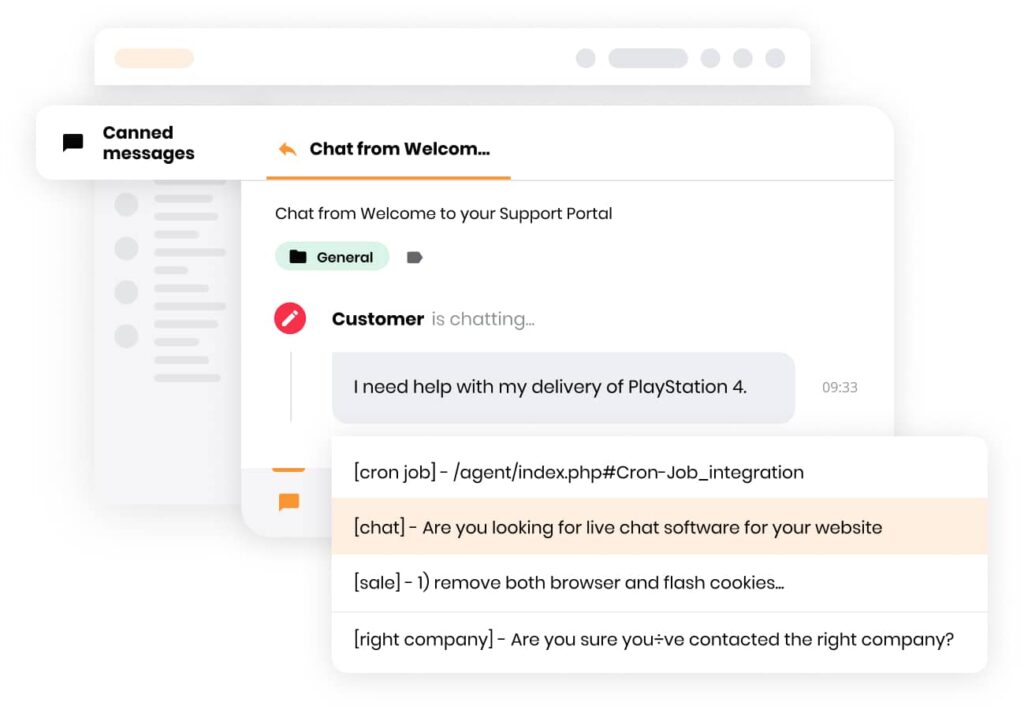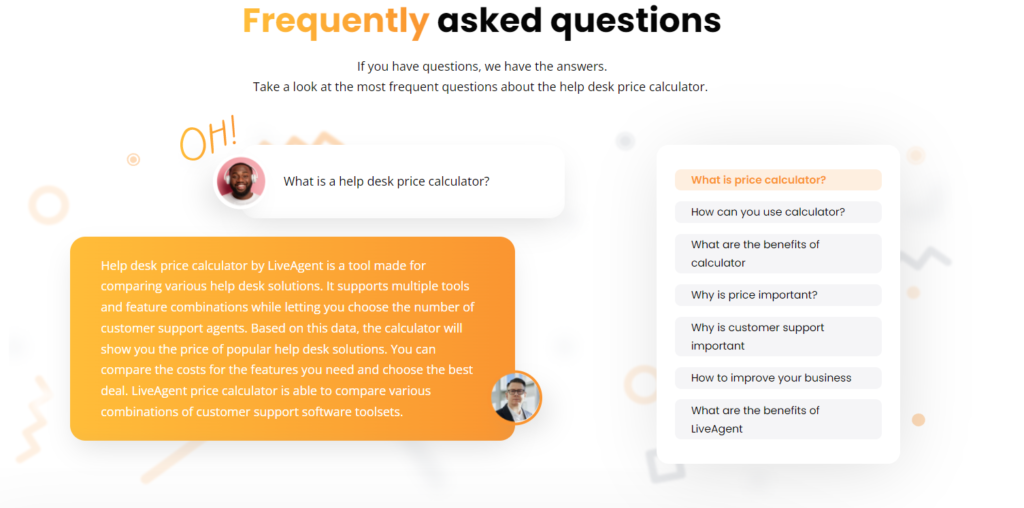- All checklists
- HR
- Crisis communication plan checklist
Crisis communication plan checklist
The crisis communication plan checklist from LiveAgent offers guidance for effective crisis communication, covering stakeholder identification, appointing communication leads, crafting message templates, choosing communication channels, training personnel, and regular plan updates.

- Identify your stakeholders
- Establish who will be in charge of communication during a crisis
- Make your crisis communication professional aware of their responsibilities
- Determine what channels will be used for crisis communication efforts using LiveAgent
- Create templates for key messages to ensure consistency
- Draft an FAQ to help answer common questions from stakeholders
- Plan for how you will handle inquiries from the media
- Outline a process for communicating with employees during times of crisis
- Train key personnel on your emergency action plan
- Review and update your online crisis communication plan regularly
A crisis communication plan is an important tool that can help organizations get their message across effectively in times of crisis. The following checklist can help you create a comprehensive strategy for achieving your communication goals in times of crisis.
The importance of a crisis communication plan checklist
No matter what industry you work in, it’s important to have a crisis communications plan in place. An unexpected situation can occur at any time, e.g. public health emergencies such as the Covid-19 crisis, so being prepared can help you communicate effectively and minimize the impact on your business.
One of the most important characteristics in crisis communication is planning ahead. By taking the time to develop a plan for communication in times of crisis before one occurs, you can ensure that you have a clear and concise strategy to follow if and when disaster strikes. A checklist can help you identify the key elements of effective risk communication strategies, meaning that you will be prepared for anything.
Who can benefit from a crisis communication plan checklist
Any organization can benefit from having a crisis communication strategy in place. Whether you work in the private or public sector, or are a non-profit organization, being prepared for a crisis is essential. A crisis communication plan checklist can help you get started on developing an effective strategy for doing just that.
- Business owners
If you own or run a business, then you need to be prepared for the possibility of a crisis. A crisis communication plan checklist can help you get ready to respond if disaster does happen to strike.
- Managers
If you manage a team of people, then you need to be prepared for the possibility of a crisis. It will be your responsibility to ensure that everyone knows what to do and how to communicate effectively if a crisis does occur.
- Employees
If you are an employee, then you need to be aware of your company’s crisis communication strategy. In the event of a crisis, it will be important for you to know how to communicate with customers, clients, and the general public.
Explore our crisis communication plan checklist
There are a few characteristics in crisis communication that should be included in every plan. Here we’ve outlined what we believe to be the most important components of an effective crisis communication strategy.
This includes anyone who could be impacted by the crisis, such as employees, customers, suppliers, investors, and so on.
Why is it important to identify your stakeholders?
It’s important to consider how each of these groups will be affected by the crisis and what their specific needs and concerns might be. This will help you to tailor your crisis communication strategy to meet the needs of each group.
How to identify your stakeholders?
Consider who could be affected by the crisis, both positively and negatively, and think about who has a vested interest in the outcome. For example, if you are a business owner, then your employees, customers, suppliers, and investors would all be considered stakeholders. If you are a non-profit organization, then your stakeholders might include donors, volunteers, beneficiaries, and the general public.
What tools to use for identifying your stakeholders?
- stakeholder analysis tool – to create a visual map of your stakeholders
- spreadsheet or table – to list out your stakeholders and their interest
They might be a single individual, such as the CEO or president, or it could be a team of people.
Why is it important to establish who will be in charge of communication during a crisis?
It’s important to have someone in charge of communication so that there is a clear chain of command and everyone knows who to go to for information. This will help to ensure that communication is clear and concise.
How to establish who will be in charge of communication during a crisis?
The best way to do this is to appoint someone, or a team of people, before a crisis occurs. The ideal kind of person to be in charge of communication during a crisis is someone who is level-headed and able to think clearly under pressure. They should also be good at communicating with people, both verbally and in writing.
What tools to use for establishing who will be in charge of communication during a crisis?
- spreadsheet – to list potential candidates for the role
- appointment calendar – to schedule a meeting to discuss the role and appoint someone
Once you have determined who will be in charge of crisis communication efforts, you need to make sure that person understands what is expected of them in the role.
Why is it important to make your crisis communication professional aware of their responsibilities?
The person responsible for implementing the crisis communication strategy needs to be clear on what their duties are so that they can act quickly and effectively in the event of a crisis. This involves more than just knowing the plan – they also need to be aware of the company’s overall communications strategy and be able to think on their feet.
How to make your crisis communication professional aware of their responsibilities
The best way to do this is to sit down with them and go over the plan in detail, highlighting their specific roles and responsibilities. You should also provide them with any training or resources that they need to carry out their duties effectively.
What tools to use for making your crisis communication professional aware of their responsibilities
- one-on-one meeting – to go over the plan and discuss specific roles and responsibilities
- training resources – to provide the person responsible with the knowledge and skills they need to carry out their duties effectively
- communication strategy – to ensure that the person responsible is aware of the company’s overall communications strategy
Decide which channels (e.g. email, text messaging, social media) will be used for communication in advance so that you can quickly get the word out when an emergency arises.
Why is it important to determine what channels will be used for crisis communication efforts?
During a crisis, it’s important to communicate with your team and stakeholders using the channels that will reach them most effectively. It is also important to determine what channels will be used for communication in advance so that you can quickly get the word out when an emergency arises. This way, you can ensure that everyone receives the same message and that no one is left in the dark during a time of crisis.
How to determine what channels will be used for crisis communication efforts?
Consider who your audience is and what methods of communication they are most likely to respond to. For example, if internal communications with employees require a method that they can access easily during work hours, such as email or an intranet system. If you’re communicating with customers then you’ll need to use a method that they can access at any time, like social media or the company website.

What tools to use for determining what channels will be used for crisis communication efforts?
- spreadsheet – to list out the different channels and their audiences
- research – to find out which channels are most effective for reaching your audience (e.g. analysis of Twitter posts)
- survey tool – to ask your team or audience which channels they prefer (i.e. what is their perspective on crisis communication from your organization)
- analysis tool – look at data from past crises to see which channels were most effective in reaching your target audience
- LiveAgent – for communicating across all chosen channels during a crisis
This is a good way to ensure that all communication across every channel is consistent, regardless of who is sending them.
Why is it important to create templates for key messages?
Consistency is important in crisis communication because it helps to build trust with your audience. If they see the same message coming from different sources, the recipients are more likely to believe that it is true. Additionally, consistent messaging will help to prevent confusion and ensure that everyone is on the same page.
How to create templates for key messages?
You will need to consider the different channels that you will be using and create a template for each one. For example, if you’re using email then you should create a message template that can be easily customized with the relevant information. On social media you’ll want to create a template that can be used across all of the different platforms that you’re present on.

What tools to use for creating templates for key messages?
- text editor – to write out the template
- graphic design software – to create an visually appealing template
Having answers prepared to frequently asked questions (FAQs) can be a useful way to provide information to stakeholders during a crisis.
Why is it important to draft an FAQ?
Having an FAQ page on your website helps to prevent confusion and ensure that everyone is receiving the same information. Additionally, it can help to save time as you won’t need to answer the same, commonly repeated questions multiple times.
How to draft an FAQ?
You will need to consider who your audience is and what questions they are likely to have. For example, if you’re communicating with employees then you’ll want to include questions about the company’s policy on emergencies. If you’re communicating with customers then you’ll need to include questions about how the crisis will affect them.

What tools to use for drafting an FAQ?
- text editor – to write out the FAQ
- research tool – to find out what questions your audience is likely to have (e.g. analysis of Twitter posts)
During a crisis, the media can be a powerful tool for getting information out to the public.
Why is it important to plan for how you will handle inquiries from the media?
Although the media can be a powerful way to reach your audience during a crisis, they can also be intrusive and disruptive. As such, you need to have a plan for how you will handle media inquiries. If you are able to control the message that the media disseminates, you can help to ensure that your audience receives accurate and timely information.
How to plan for handling inquiries from the media?
There are several questions you must answer, including “Is it best to appoint a spokesperson who will be the primary point of contact for the media?”, “Will we hold a press conference?”, and “Should we issue a press release?” You also need to think about what information you will release to the media and how you will release it.
What tools to use for handling inquiries from the media?
- training – to prepare the designated spokesperson for effectively communicate your message to the media
- text editor – to prepare a list of key points that they will need to hit in any interviews
- review tool – to check the key talking points with the crisis communications team beforehand
At times of crisis, it is essential to have a plan for communicating with employees so that everyone will be on the same page and accurate information being disseminated.
Why is it important to outline a process for communicating with employees during times of crisis?
It is important to communicate with employees during a crisis so that everyone knows what is happening and what the company’s crisis response will be. Additionally, this can help to prevent rumors and speculation from spreading.

How to outline a process for communicating with employees during times of crisis?
First designate who will be responsible for communicating with employees, which could be the HR department or someone in communications. Then you need to determine how you will communicate with employees – for example, will you send out an email, hold a meeting, or record a video message? This will depend on the size of your company and the severity of the crisis.
What tools to use for communicating with employees during times of crisis?
- email client – for sending messages via the internet
- meeting scheduler – to arrange a suitable time to discuss the crisis
- webinar software – to conduct an online meeting or record a video message
Once you have created your crisis communication strategy, it is time to train key personnel on the plan so that they know what to do in the event of a crisis.
Why is it important to train key personnel on your emergency action plan?
They are the people who will be responsible for implementing the plan in the event of a crisis. By training them ahead of time, you can be sure that they will know what to do if disaster strikes and are prepared for any eventuality.
How to train key personnel on your emergency action plan?
The first step is to identify who your key personnel are – these are typically people in management or communications positions. Next you need to provide them with training on the crisis communication plan, which can be done through a variety of methods such as in-person training sessions, an online course, or a printed manual.
What tools to use for training key personnel on your emergency action plan?
- training manual – to provide an easily accessible overview of the crisis communication plan
- online course – to provide a more interactive training experience
- in-person training – to ensure that key personnel understand the plan and are comfortable with it
Your online crisis communication plan is not a static document – it should be reviewed and updated regularly to ensure that it remains relevant and effective, as well as stored digitally for easy access.
Why is it important to review and update your online crisis communication plan regularly?
The world changes quickly, and something that could once be considered effective communication in times of crisis may no longer be. Additionally, as your company grows and changes, your plan and communication goals will need to change with it. By reviewing and updating the plan on a regular basis, you can be sure that it will always stay up-to-date.
How to review and update your online crisis communication plan regularly?
Set aside time at least once a year, or after some other predetermined period, to review the entire document and make any necessary changes. You should also update the plan whenever there are significant changes to your company, such as a change in management or a new product launch.
What tools to use for reviewing and updating your online crisis communication plan?
- annual review – to get a perspective on crisis communication in your organization ensure that the plan is still relevant and effective
- change tracking software – to keep a record of any modifications made to the plan over time
- project management software – to help with coordinating the review and update process
Tips for staying calm during a crisis
Avoid making assumptions
When faced with a crisis, it can be tempting to make assumptions about what is happening and what needs to be done. However, this can often lead to more problems than it solves. It is important to stay calm and avoid making assumptions so that you can think clearly and make the best decisions possible.
Take regular breaks
During a crisis, it is important to stay focused and on task. However, this can be difficult to do if you are feeling overwhelmed or stressed. If you find yourself in this situation, take a break as and when needed so that you can come back to the problem refreshed and ready to tackle it. If you don’t have time to take a proper break, at least pause for breath and try to clear your head for a few minutes.
Avoid making hasty decisions
When you are under pressure, it can be easy to make rash decisions that you later regret. If possible, avoid making any major decisions until the crisis has passed and you have had time to think things through. If you do need to make a decision, take your time and weigh up all the options before committing to anything.
Lead with transparency and honesty
In times of crisis, it is important to be open with your team, your clients, and the public. Be upfront about what you know and don’t know – people will appreciate your candor and this will help build trust with them. It will also mean that everyone is being accurately informed about what is happening.
Focus on taking care of yourself first
It can be easy to forget about your own needs during difficult periods. However, it is important to take care of yourself first and foremost. This means making sure that you are eating and sleeping properly, exercising regularly, and taking time for yourself when you need it. Doing these things will put you in a better position to deal with the crisis and help others.
Summary of the crisis communication plan checklist
- Identify your stakeholders
- Establish who will be in charge of communication during a crisis
- Make your crisis communication professional aware of their responsibilities
- Determine what channels will be used for crisis communication efforts using LiveAgent
- Create templates for key messages to ensure consistency
- Draft an FAQ to help answer common questions from stakeholders
- Plan for how you will handle inquiries from the media
- Outline a process for communicating with employees during times of crisis
- Train key personnel on your emergency action plan
- Review and update your online crisis communication plan regularly
Frequently Asked Questions
What are 5 things that need to be included in a crisis plan?
The name(s) of the person(s) who will take charge in the event of a crisis. A clear and concise outline of the crisis situation and what actions need to be taken. A list of key personnel and their contact information. Procedures for safeguarding company property and confidential information. Protocols for communication with employees, customers, and the media.
How often should a crisis communication plan be updated?
There is no one-size-fits-all answer to this question, as the frequency with which a crisis communication plan should be updated will vary depending on the organization’s risk profile and the nature of the risks it faces. However, most experts agree that a crisis communication plan should be reviewed and updated at least on an annual basis.
What are the benefits of having a crisis communication plan?
Perhaps the most obvious advantage is that it can help you effectively manage and respond to a crisis situation, minimizing the damage to your organization and its reputation. Planning ahead, which is one of the key characteristics in crisis communication, will also help you to anticipate and prepare for potential crises, identify key stakeholders and develop appropriate messages for each group, manage incoming information during a crisis situation ,coordinate efforts among various departments within your organization, and evaluate the effectiveness of your crisis response after it has subsided. Simply put, having a well thought out plan can mean the difference between successfully weathering a storm and being overwhelmed by it. If your business is not prepared for public health emergencies such as the Covid-19 crisis, now would be a good time to plan for any other disasters that might occur in future.
Who should be in charge of communication during a crisis?
Clear and effective communication in times of crisis is essential for ensuring that everyone is on the same page and knows what needs to be done. While there are many different people who could potentially be in charge of communication during a crisis, it is important to choose someone who will be able to remain calm under pressure and convey all the relevant information clearly and concisely. One person who could potentially be in charge of communication during a crisis is a team leader or supervisor – they would be responsible for ensuring that all team members are kept up-to-date on developments and have a clear understanding of what needs to be done. Another option would be to appoint a dedicated communications officer whose sole responsibility would be to manage all communication during a crisis – this person would need to be adept at handling high-pressure situations and have a keen understanding of how to effectively communicate with different audiences.
What are the six steps of handling a crisis?
The main aspects of your crisis communication efforts should be to: Assess the situation and determine the best course of action. Act quickly to mitigate the damage and prevent additional losses. Communicate with key stakeholders. Manage the media and their perspective on crisis communication from your organization. Deal with any legal issues. Evaluate the crisis response and if your communication goals were met.
You will be
in Good Hands!
Join our community of happy clients and provide excellent customer support with LiveAgent.

Our website uses cookies. By continuing we assume your permission to deploy cookies as detailed in our privacy and cookies policy.

- How to achieve your business goals with LiveAgent
- Tour of the LiveAgent so you can get an idea of how it works
- Answers to any questions you may have about LiveAgent

 Български
Български  Čeština
Čeština  Dansk
Dansk  Deutsch
Deutsch  Eesti
Eesti  Español
Español  Français
Français  Ελληνικα
Ελληνικα  Hrvatski
Hrvatski  Italiano
Italiano  Latviešu
Latviešu  Lietuviškai
Lietuviškai  Magyar
Magyar  Nederlands
Nederlands  Norsk bokmål
Norsk bokmål  Polski
Polski  Română
Română  Русский
Русский  Slovenčina
Slovenčina  Slovenščina
Slovenščina  简体中文
简体中文  Tagalog
Tagalog  Tiếng Việt
Tiếng Việt  العربية
العربية  Português
Português 